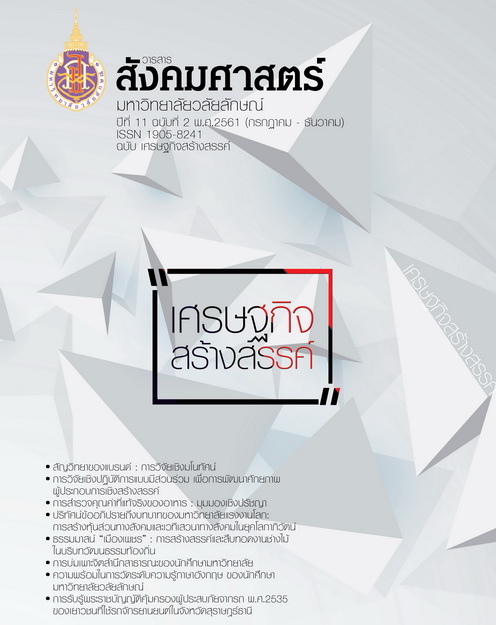Participatory Action Research for Creative Entrepreneurship Development
Main Article Content
Abstract
This article discusses the concept meaning, purpose, nature of participatory action research (Participatory action research) and includes relevant participatory action research. The study also covers the concept meaning of creative entrepreneurs. The objective is to conduct participatory research for the development of potential entrepreneurs. The content is presented as a hierarchy of participatory action research processes, namely, 1) Steps of contextual study, 2) Steps of problem solving, 3) Steps of research planning, 4) Steps of monitoring and improvement, and 5) Steps of research conclusion. The concept of creativity is used in the analysis of participatory action research to develop creative entrepreneurial potential. Participatory action research is a method of ideological research with its unique way of conduct, which requires the researcher to learn and understand thoroughly. Everyone is involved in every step of the deal from determining the problem, selecting a data collection method, data analysis, data validation and deciding to follow the plan and analyze the performance. This is a research approach that can develop the potential of creative entrepreneurs as well as those involved. Finally, we propose a participatory action research approach to develop creative entrepreneurship.
Article Details
Copyright: CC BY-NC-ND 4.0
References
Bilton, C. (2007). Management and creativity: Fromcreative industries to creative management. Oxford, UK: Blackwell.
Boone, L. W. (1990). Creative thinking in business organizations. Business Journal, 12, 3.
Bureau of Standards, Social Development and Human Security. (2006). The process of creating social networking and social welfare networks. Bangkok, Thailand: Ministry of social development and human security.
Creswell, J. W. (2002). Educational research: Planning, conducting, and evaluating quantitative and qualitative research. NJ: Merrill Prentice Hall.
Chalarak, P. (2006). Participatory action research. Western Rajabhat University, 1(1), 17-23.
Chieokok, C., & Yaemai, S. (2016). Participatory action research in community development. Journal of Hatyai Academic, 14(1), 79-95.
Crumpton, M. A. (2012). Innovation and entrepreneurship. The Bottom Line: Managing Library Finances, 25(3), 98-101.
Khansawai, F. (2012). Characteristics of successful entrepreneurs in hotel business in the lower northern provinces of Thailand. Journal of Management Science and Information Science Naresuan University, 7(1), 39-50.
Fryer, D., & Feather, N. T. (1994). Intervention techniques. In C. Cassell & G. Symon (Eds.), Qualitative methods in organizational research, (pp. 230-247). London, England: Sage.
Finklestien, R. (2006). What successful businesses have in common. Retrieved from http://www.entrepreneur.com
Greenwood, D., & Levin, M. (2002). Introduction to Action Research for Social Change. Thousand Oaks, CA: Sage.
Harper, S. C. (1991). The McGraw–Hill guide to starting your own business. NY: McGraw-Hill.
Chiewcharoensakul, S. (2002). Development of a training model for the food business. Vocational Education. Bangkok, Thailand: Kasetsart University.
Chuito S. (2005). New innovation management. Nonthaburi, Thailand: Sukhothai Thammathirat University.
Jerald, S G. (1996). “Virtual Teaching in Higher Education” the new intellectual superhighway of just another traffic jam? Retrieved from http://www.csun.
edu /sociology/virexp.html
Kemmis, S., & McTaggart, R. (1988). The action research planner. Melbourne, Australia: Deakin University Press.
Kanchanasinon, K. (2015). Structure and access to rural informal networks. (Master of Thesis, Srinakharinwirot University).
Howkins, J. (2001). The Creative economy: How people make money from ideas. London, England: Penguin Books.
Lee, C., Egbu, C., Boyd, D., Xiao, H., & Chinyo, E. (2005). Knowledge management for small medium enterprises: capturing and communicating learning and experiences. Paper presented at the 4th Triennial CIB W99 Safety Health Environment Quality Conference, Port Elizabeth, South Africa. http://usir.salford.ac.uk/2847
Merriam, S. B. (2002). Qualitative research and case study applications in education.San Francisco, CA: Jossey-Bass.
Ministry of Commerce. (2016). Strategic plan, Ministry of Commerce, 2016 - 2021. Bangkok, Thailand: Ministry of Commerce.
Kamphængphet, M. (2009). Thai entrepreneurs in the creative economy. FEU Academic Review, 3(2), 52-56.
Neely, A., Adams, C., & Kennerley, M. (2002). The performance prism: The scorecard for measuring and managing business success. Harlow, IA: Pearson Education.
Ngoenprasoetsi, N. (2014). Participatory action research. Journal of Social Science, 27, 61-73.
National Economic and Social Development Board, Office. (2017). Development Plan of the Society and National Society no.12 (2017-2021). Retrieved from http://www.nesdb.go.th
Kotsoli, P C. (2010). Take a lesson in creative economy from abroad. Economic and Social Journal, 47(4), 32-37.
Phon̜phiphat, P. (2010). Creative economy. Economic and Social Journal, 47(4), 81-114.
Ketkaew, P. (2008). Relationship between job characteristics recognition. The ability to face and overcome obstacles to happiness in the work of nurses. Nursing work. (Master’s Thesis, Thammasat University).
Sangsuwan, P. (2012). Factors affecting the success of small and medium enterprises in construction sector in Bangkok Metropolis. (Master’s Thesis, Ramkhamhaeng University).
Schutt, R. K. (1996). Investigating the social world: The process and practice of research. Thousand Oaks, CA: Pine Forge Press.
Yangyưn, S. et al. (2013). Participatory Research in Waste Bank Management of Baan Hua Nong, Tambon Khamruen, Kantharawichai District Mahasarakham province. KKU Journal for Public Health Research, 6(3). 45-52.
Sirikutta, S. (2013). Creative economy strategies that affect business success: a case study of upper central industrial entrepreneurs. Kasetsart University (Society), 34, 428 – 439.
Stringer, E. T. (1999). Action research (2nd ed.). CA: SAGE.
Wanitwirun, K. (2009). Creative economy: How he was rich in ideas. Bangkok, Thailand: Center for Creative Design.
Whyte, W. F. (1991). Participatory action research. London, England: Sage.
Wisetmongkhon, C. (2010). Entrepreneurs in the Creative Economy. Retrieved from http://www.manager.co.th/SMEs/ViewNews.aspx?NewsID=9530000131454


